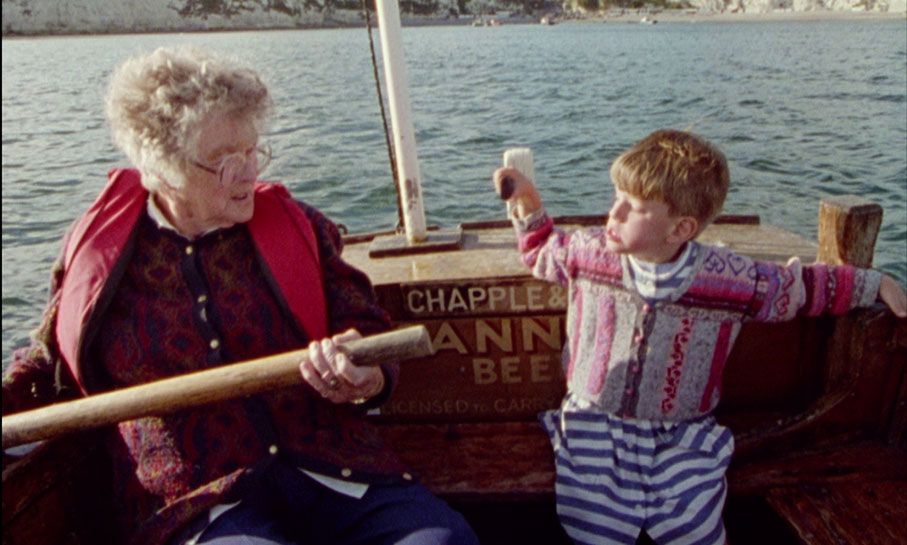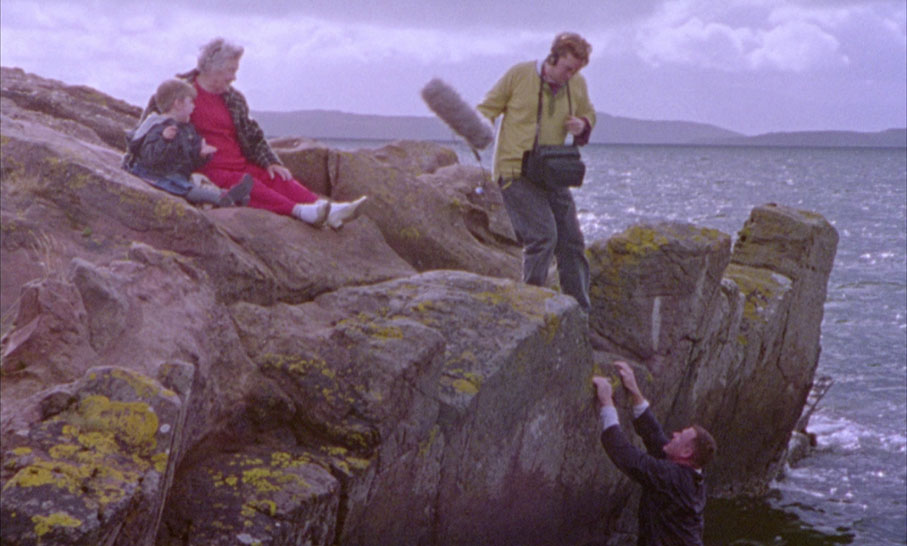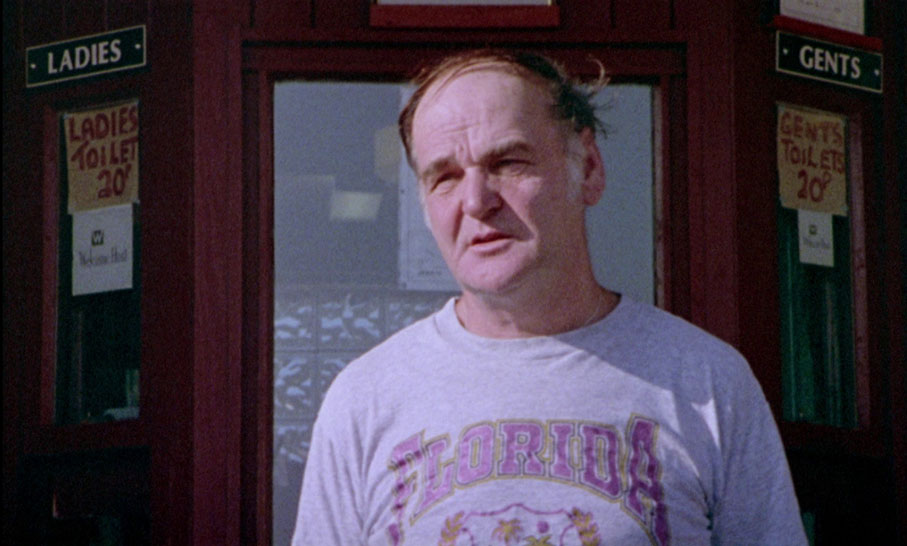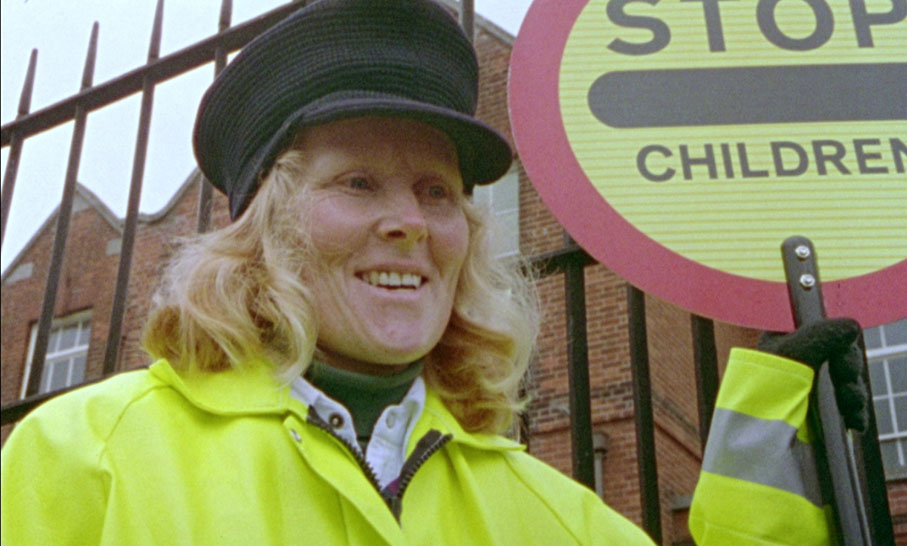|
In 1995, filmmaker Andrew Kötting went on a four-month journey around the coast of Great Britain, beginning and ending at the De La Warr Pavilion in Bexhill-on-Sea. With him for most of the journey were his ninety-year-old grandmother Gladys Morris and his seven-year-old daughter Eden, who has a rare neurological condition, Joubert Syndrome. Gallivant is the film of that journey, made with Super 16mm and Super 8mm cameramen and a sound recordist. Kötting says in his narration that he wanted his grandmother and daughter to have time together that they hadn't had. He was aware that time might be short, due to Gladys's age and Eden's limited life expectancy, as detailed by a doctor near the start. (Most children with Joubert Syndrome don't live long into adulthood, if at all. However, happily, as you'll see from the short films on this disc and read in the booklet with it, Eden is still with us.)
From that description, Gallivant sounds like a travelogue you might see on TV. In fact, it could almost be the template of the BBC series Coast, which began a decade later. Both Gallivant and Coast take time to look at the features of the places they visit and interview some eccentric locals. However, if there was a connection (as far as I'm aware there wasn't) the film and the TV series are quite different – in short, Coast has none of Kötting's filmmaking idiosyncrasies. While most of the film was shot in Super 16mm, at times he'll cut in Super 8mm footage, sometimes speeded up while the soundtrack plays at normal speed, and also uses archive sound and visual material. In fact, the use of sound is often striking, from the surround-sound announcements when they visit Goonhilly Earth Station, to the loud squeals when the camera takes us inside a Southwold piggery.
At times, Gallivant is like an upscaled home movie, in the best way. When he is rejoined by Gladys and Eden, he is sure to record the scene which shows that Eden since he last saw her has learned to walk unaided. There are also scenes which you might have captured on your cine camera, camcorder or nowadays smartphone, with Kötting falling in the sea at one point. ("Silly bugger," says Gladys.) The film ends back in Bexhill-on-Sea with Gladys and Eden on the beach. The two of them, great-grandmother and great-granddaughter, one near the end of her life and the other early on in hers, embrace. It's the relationship between these two, getting to know each other during the journey, which gives the film its heart.

However, the film is also a tribute to the British coastline and countryside. Gladys talks to an old man about how the countryside is declining, with motorways built in its place. Gallivant has an eye for local folklore and customs, such as a recreation of the legend of Giant Bolster in St Agnes, Cornwall. And some of the people they meet are engagingly eccentric, including some inhabitants of Whitehaven, Cumbria, demonstrating the practice of gurning, and the proud proprietor of the award-winning superloo (20p to use) in Kyle of Lochalsh, an establishment decorated with postcards, pictures and the plaques for the awards it has won. (Kötting helpfully provides us with the address to send cards to although, twenty-eight years later, Google fails to tell me if the establishment still exists.) We see a demonstration of long-sword dancing and interview a lollipop lady in Lowestoft. Some of this is very funny: a woman's deadpan response to Kötting's question about her sheep herd is priceless. Not all of the people Kötting meets are friendly, however: he captures the voice of a man in Middlesbrough telling him to fuck off down South.
Gallivant was Kötting's first feature film in a prolific career. It's one of his most accessible, as many of his films are avant-garde in style, verging on the abstract. (There's a good sampling of his short work in the extras, see below.) Gallivant is certainly idiosyncratic, but it's a warm, often funny film, a love letter to his native land and a moving story of a bond forming between two people three generations apart.
The BFI's release of Gallivant is a limited-edition Blu-ray encoded for all regions. The film itself has a 15 certificate. Of the short films, the only ones appearing on the BBFC database as I write this are Hoi-Polloi as a 12A for cinema release, and for homeviewing Dog Ate Dog (15), In Far Away Land (PG) and Diseased and Disorderly (U). I presume the other films will appear in due course, as many aren't technically documentaries and have content which would rate them beyond PG, be it language (strong, racist or ableist), occasional nudity, and in the case of Là Bas, some comic nude sexual scenes. [Update: I have been advised by the BFI that the earlier short films on the disc were certified as a package in 2005 at 15.]
Gallivant was shot mostly in Super 16mm, with some footage in Super 8mm and Hi-8 video, blown up to 35mm for cinema distribution. This Blu-ray transfer is based on a 2K remastering from the 35mm interpositive and is in the aspect ratio of 1.66:1. The picture is often soft and certainly grainy, but that's due to the film's 16mm origins, with the Super 8mm footage even grainier. I haven't seen the film in a cinema, but I've no reason to doubt that this looks much as it did there.
Many of the short films are in the aspect ratio of 1.33:1, reflecting the source material, often Super 8mm and/or 16mm and/or Hi-8 video. The first exception is Là Bas, shot in grainy black and white 35mm and in the ratio of 1.78:1. Dog Ate Dog, In Far Away Land and Diseased and Disorderly were made between 2018 and 2021 when HD video was available and are also in 1.78:1. The Buzz of the Past, also shot in HD with some Super 8mm inserts, is in the ratio of 1.60:1.
The film played in cinemas with a Dolby Stereo soundtrack, rendered in LPCM 2.0 for this release. It plays in surround, with the main beneficiary being the music and some ambient sound, though as mentioned above there is some play with directional sound in the sequence visiting Goonhilly Earth Station. There are some onscreen subtitles translating Eden's speech and sign language, and hard-of-hearing English subtitles are available for the feature and, I'm pleased to be able to say, all of the extras too. I can't remember the last time I watched a disc where that was the case, so full marks to the BFI. I spotted a couple of errors ("cost" for "coast" in the main feature, "shi-shi" for "chi-chi" in the St Leonards-on-Sea featurette) and there are places where they inevitably simplify what's heard a little, but they're for the most part accurate and a welcome addition for the hard-of-hearing and, due to some regional accents, those whose first language isn't English.
A Gallivant round St Leonards-on-Sea with Andrew Kötting (31:06)
Made in 2021, filmmaker John Rogers, a great admirer of Gallivant, takes a train down to St Leonards-on-Sea to meet Andrew Kötting, and they take a mini-gallivant round Kötting's home base. That's St Leonards-on-Sea, not Hastings, as he points out, the difference between the two being about a mile and a half. In their walk around the town, they take in Kötting's local butcher's, hairdresser's, chippy and bookshop, and they visit his studio, where Eden pays a visit. Also included is the statue of Edith Swan-Neck, wife of the King Harold defeated and killed at Hastings, and the subject of Kötting's 2017 film Edith Walks. This featurette has something of the feel of the film it was inspired by and pays tribute to, with its sense of deep local history and present-day human eccentricity.
The remaining on-disc extras are a selection of Kötting's short films, count them fifteen in total, which have a Play All option if you are inclined to watch all 163:34 in one go. They cover his career from his first film to his most recent.

Klipperty Klöpp (13:21)
Kötting's first short film, from 1984, and starting a tradition of idiosyncratic diacritic marks in titles and credits, presumably due to the umlaut in his own surname. Shot by his partner Leila McMillan (and Eden's mother, though this was four years before she was born) in very soft and grainy black and white Super 8mm, with a voiceover and music. Like many of Kötting's shorts it's not easy to describe other than in the terms he gives himself: "a post-punk piece of pagan sensibility, complete with bestiality, buggery and boundless energy". Or it's a man running round crop circles in somewhat speeded-up motion, shot from overhead, with a deadpan voiceover.
Hoi-Polloi (11:17)
From 1990, a film made up of cut-up imagery (shot again in Super 8mm and 16mm, in colour this time) with sound overlays, about people living on the edges of society. It has Eden Kötting's first appearance on film, aged two, and Gladys Morris can be heard on the soundtrack.
Acumen (24:09)
A 1991 film, made for Channel 4, shot in 16mm colour. It's set on a beach inhabited my various characters and items from their lives, with a bag lady walking down the white lines in the centre of the road. Kötting sees this as "codified autobiography", a series of vignettes "that stubbornly refuses to reveal any literal meaning" and indeed it doesn't, clearly a private work. Gladys Morris appears again, with her husband Albert, and also future Kötting collaborator the late Sean Lock (spelled "Locke" in the end credits), playing "artist buried under the weight of his own importance".
H.B. 1829 (his bad blöod) (6:14)
A kind of travelogue, shot on the island of Jura and the French Pyrenees, with none other than Johnny Cash on the soundtrack at the start. But then, the soundtrack overlaying the Super 8mm images (some of them speeded up) is Heilco van der Ploeg's singing a folk song, "I Wish I Was a Little Birdy". A very very early seed for what would later become Gallivant.
Diddyköy (6:22)
Made in collaboration with N.R.G. (Nick Gordon) Smith, who co-directed and shot the film, this is more of a conventional short documentary, with Super 8mm footage of a travellers' horse fair overlaid with the voices of presumably local people on the soundtrack. Some of them disparage the people we see on screen and use what an introductory caption warns is racist language. However, this is another seed for Gallivant, a celebration of tradition and heritage. Smith continued to be a Kötting collaborator and was behind the camera on Gallivant.
Smart Alek (19:44)
Made for Channel 4's "Summer shorts" series in 1993, in 16mm, this is far more of a conventional narrative than Kötting had made up to now. A family is driving to Jaywick Sands for a holiday and tensions are high, with the son in the back seat doing almost all except asking "Are we there yet?" Again, Kötting makes much use of sound, with the cacophonous sound mix putting the audience on edge. There's a car accident and a threatening encounter with the title character (Sean Lock). The film begins with a caption advising of ableist language (the word beginning with S for someone with cerebral palsy).
Là Bas (Down There) (20:20)
This was a commission from the BBC for a 1994 series called Continental Drift, to mark the opening of the Channel Tunnel. It was shot in 35mm, Kötting's first film in that gauge, in grainy black and white. The Tunnel is a rail tunnel, the third-longest in the world, but Kötting imagines a foot tunnel, with tickets being sold. A Frenchwoman, Angeline (Roberta Fox), and her lover meet some eccentric people in a Bexhill-on-Sea bed-and-breakfast, with much of the dialogue in French with some wayward subtitling. It was broadcast on 11 May 1994 and you wonder what BBC2's audience made of it.

Gallivant (The Pilot) (8:21)
This was shot on Super 8mm as an application for an Arts Council grant, which was not successful. However, Kötting worked with the production company Tall Stories and developed the Gallivant which was eventually made, particularly with the inclusion of Gladys and Eden. This pilot doesn't bear a great deal of resemblance to the feature, being a cut-up of brief images with voiceovers.
Jaunt (5:52)
Another predecessor for Gallivant, this follows a riverboat trip starting at Southend-on-Sea and ending outside the Houses of Parliament. It features such Kötting techniques as speeding up the film but keeping the soundtrack at normal speed.
Invalids (1:38)
Another observational piece, a brief one observing pilgrims at Lourdes, shot in blurry, step-printed Super 8mm with voices on the soundtrack. Some of their language is ableist, which earns this film an advisory caption at the start.
Me (4:56)
Dated 2000, this footage was originally part of Gallivant but was removed from the film and completed later. The "Me" is of course Kötting, who sees this film as a portrait of an artist as halfwit. It's another series of Super 8mm images cut up and set to a disjunctive soundtrack. You hear Gladys Morris on the soundtrack saying to Eden, "When your Daddy was a little girl", which we see at the start of Gallivant.
Dog Ate Dog (13:52)
We move on to 2013 and the era of digital video enables shooting in HD. By now, Eden Kötting was collaborating with her father and this is a companion piece to his feature film Lek and the Dogs. This is a look into Eden's world, animated by Glenn Whiting from her drawings, writings and collages.
In Far Away Land (6:10)
Another father/daughter collaboration and companion piece, this time to the 2019 feature The Whalebone Box. It's along similar lines to Dog Ate Dog, made up of animated drawings and collages and a disjunctive soundtrack.
Diseased and Disorderly (13:24)
A third collaboration by the Köttings, and we see Eden in person at her desk drawing, those drawings then becoming animations. The film also includes some 3D computer-animated sequences by Isabel Skinner, a former student of Andrew Kötting.
The Buzz of the Past (7:47)
Made in 2020 as a commission from Manchester's HOME as part of a season devoted to the late Derek Jarman, this was shot on HD video, with some Super 8mm inserts. In particular it references Jarman's film The Garden and played as a curtain-raiser to it. The Köttings and two others, Bob and Claire Humm, visit Jarman's cottage in Dungeness, where he shot The Garden, and then his grave. Gladys Morris's and Jarman's voices are on the soundtrack.
Booklet
The booklet with this BFI limited edition runs to forty pages. It begins with Kötting's treatment for Gallivant, which, he says, more by luck than design ended up close to the eventual film. It also has a description of a pre-title sequence, which is different to the one in the film which features a weatherman delivering his forecast by sign language, and a little about Gladys and Eden. It reveals that the original intention was to shoot in 35mm, but when the film was greenlit, the necessity was to use Super 16mm, blown up to 35mm for the cinema. The Super 8mm inserts were there from the start, though.

Next up is Kötting collaborator Iain Sinclair, in a piece reprinted from Sight & Sound. He begins by doubting there can be such a thing as a British road movie, as the island is too small: you can drive from end to end in about eighteen hours. He associates Kötting with other British filmmakers, such as Christopher Petit (whose Radio On is a British road movie) and the major of psychogeographic semi-documentaries Patrick Keiller (London, Robinson in Space) and describes the progression of the film as it progresses clockwise round the coast of Great Britain.
"As They Blunder Önwards" (that stray umlaut again), is a profile by Jason Wood of Kötting, followed by an interview with him. Kötting acknowledges that Gallivant had its roots in his previous work, such as Jaunt. When the BFI gave Gallivant the go-ahead, they were keen to have central characters in the film, which were roles taken by Gladys and Eden. Kötting took inspiration from Ross McElwee's 1986 two-and-a-half-hour personal documentary Sherman's March and the 1972 The Moon and the Sledgehammer, detailing a family living in a manner which would now be called off-grid. After making Gallivant, Kötting was so exhausted he didn't make another feature until This Filthy Earth in 2001. He talks about his use of cut-ups and speeded-up images, which he attributes to a love of Dada, and the role of happenstance in the making of Gallivant. He also talks about his collaborations with Nick Gordon Smith and with Eden, who he finds "unfathomable".
A brief biography of Kötting father and daughter is followed by notes on the extras on this disc, by John Rogers on his own featurette and by Andrew Kötting on the short films included. Also in the booklet are plenty of stills.
Gallivant is an eccentric road movie crossed with a documentary tribute to the British coastal landscape, its traditions and human eccentricity, as well as a moving story about a woman near the end of her life and a girl near the start of hers forming a bond. It's one of the most accessible works of a prolific and idiosyncratic filmmaker, and the large selection of his short films makes this a valuable Blu-ray release from the BFI.
|